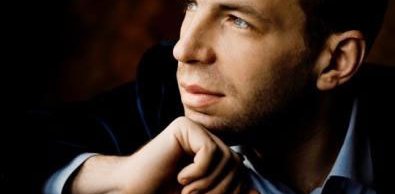Some cannot quite conceal their disappointment over a soloist change. Personally, I look forward to the new situation, because at many times it came about that the – to me unknown – musician understudying the artist originally listed in the programme produced a pleasant surprise. At the press conference held before the Budapest Festival Orchestra’s concert on 28 January, I was thus open-minded to the news that for personal reasons, Alexander Toradze, having performed at the first three events, had cancelled his performance on the last day of the BFO programme – which is usually offered to audiences three times, or four times if the Midnight Concert in the Millenáris Theatre is included – and consequently the young Andrei Korobeinikov (1986) quickly agreed to understudy his renowned colleague residing in America.
Why are Russian evenings so popular today? Many people believe that the pendulum of public opinion has swung back to an earlier state: after forty years of Russian occupation, Slavonic music was not popular with Hungarians right after the fall of communism, but twenty-five years has since passed, and slowly everything is falling into place. Over time, nothing forced us to recognise the genius of Shostakovich and Prokofiev, and now we know that they were not only liked because people were cowed by the Soviet regime, but also because their music is capable of and worth filling our souls – and their opuses are sufficient grounds for this. Even during the oppressive Brezhnev era, there was no denying that the rich oeuvre of Tchaikovsky and The Five is so fascinating and enjoyable. It is no wonder Iván Fischer organised a Russian programme. Polovtsian Dances (1887) by Borodin; Piano Concerto No. 3 (in C major, Op. 26 – 1921) by Prokofiev; Symphony No. 6 (in B minor, Op. 74, “Pathétique” – 1893) by Tchaikovsky.
In an unusual way, the concert began and continued with words. Iván Fischer informed the audience about the plot of Prince Igor, when the famous excerpts, the Polovtsian Dances, are played, and what their function is. This impromptu speech was delivered with an easy grace and irresistible humour (lexical knowledge was poured out to the audience imperceptibly and playfully), implying that besides the Cocoa Concerts, the BFO programme should also include concerts for adults with accompanying speeches as a new initiative. It would undoubtedly be a roaring success.
The Polovtsian Dances were played in their full splendour – with a choir. The Czech Philharmonic Choir (choirmaster: Petr Fiala) gave a world-class performance, as usual: their intense and rich sound, finely mixed vocal colours contributed to the exoticism of the musical genre art series with alternating lyrical and great power. Iván Fischer, as so often, experimented with placing the musicians unconventionally: choir members were standing between orchestral parts to blend vocal and instrumental parts naturally, while László Herboly, excellent BFO percussionist, sat quite near the front with the snare drum, in front of the choirmaster. This resulted in a healthy and rich blend of sounds. The famous Symphony No. 6 by Tchaikovsky, performed in the second part of the concert, is a dangerous piece of music: the performer can easily go too far, giving full vent to pathos, tragedy and lethargy. This leads to uncontrolled effusion, which has the worst consequence: it compromises the symphony itself, which, however, is not effusive – as convincingly proved by Fischer. He was able to keep the instances of tragedy in check, there was complaint and pain in the performance, but attention to detail and refinement played an important part too. The rendering of the opening movement was exact, fine and elaborate, the flowing character of the unconventional waltz with the Allegro con grazia tempo marking is given a subtle displacement through the use of 5/4 meter, where two beats are followed by a triple pattern. The Scherzo had a sonorous sound and very precise rhythm. Great powers were compressed into it, the triumphant march had an enormous impact and a fitting finale – my illusions were not even shattered when some people, as usual, broke into spontaneous applause in the end, since this is the real finale after all, and the subsequent actual final movement is more like an epilogue. The latter was marked by poise and dignity in spite of the slow tempo and lethargic world of expression, and when the movement, and eventually the entire piece, ended, the thud of the double basses’ heartbeats could be heard with the composure of a reconciled man.
When performing Prokofiev’s piano concertos, bluntness, fierceness, sarcasm as well as softness, refinement and a feeling for chamber music effects and pastel colours are necessities of the soloist’s stock-in-trade, because it is quite easy to put a one-sided interpretation on these compositions, exaggerating the composer’s enfant terrible persona. I admit that while listening to Toradze I often thought that, unfortunately, he is only capable of making a one-sided interpretation of Sergei Sergeyevich, so this time I observed with much more pleasure that Andrei Korobeinikov’s artistic behaviour was marked by the effect of a “free-standing sculpture” accentuated by diversity. In his performance, not only the dynamic piano parts resembling a toccata or the impressive virtuosity played an important role, but also the soft lyrical details and parts resembling chamber music – the movement of variations for example began with exceptional refinement. He played Korobeinikov’s Piano Concerto No. 3 with compelling technical perfection and impressive stamina – having received loud applause, he delivered an intense and dynamic performance of Beethoven’s Bagatelle (No. 4) in B minor, Op. 126.


